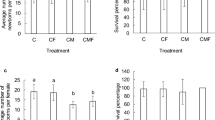Abstract
Feeding rates, growth rates, and biomass conversion efficiencies were determined for white sucker larvae and young common shiners fed natural zooplankton during one week exposures to cadmium (suckers and shiners), 2,4-dichlorophenol (DCP) (shiners only), or pentachlorophenol (PCP) (shiners only). All three toxicants significantly (P < 0.01) reduced growth rates at sublethal concentrations. Growth rates were reduced up to 67 to 100% by DCP and cadmium, but the effect was smaller (a 25% reduction) for shiners. Feeding rates were not significantly affected by cadmium or DCP exposure, but shiners exposed to PCP had significantly increased feeding rates. All toxicants, therefore, reduced conversion efficiencies by >50% at sublethal concentrations. Toxicants which reduce conversion efficiency have the potential for reducing the production of top predators (large piscivores) by an amount greater than the relative effect on any one trophic level (as demonstrated in laboratory experiments) because reductions in efficiency over multiple trophic levels are cumulative.
Similar content being viewed by others
References
Bengtsson B-E (1975) Vertebral damage in fish induced by pollutants. In: Koeman JH, Strik JJTWA (eds) Sublethal Effects of Toxic Chemicals on Aquatic Animals. Elsevier Science Publ Co, Amsterdam, pp 23–30
Borgmann U (1982) Particie-size-conversion efficiency and total animal production in pelagic ecosystems. Can J Fish Aquat Sci 39:668–674
Borgmann U, Whittle DM (1983) Particle-size-conversion efficiency and contaminant concentrations in Lake Ontario biota. Can J Fish Aquat Sci 40:328–336
Borgmann U, Shear H, Moore J (1984) Zooplankton and potential fish production in Lake Ontario. Can J Fish Aquat Sci 41:1303–1309
Borgmann U, Ralph KM (1985) Feeding, growth, and particlesize-conversion efficiency in white sucker larvae and young common shiners. Environ Bio Fishes 14:269–279
Borgmann U (1985) Predicting the effect of toxic substances on pelagic ecosystems. Sci Total Environ 44:111–121
Bostrom S-L, Johansson RG (1972) Effects of pentachlorophenol on enzymes involved in energy metabolism in the liver of the eel. Comp Biochem Physiol 41B:359–369
Collvin L (1985) The effect of copper on growth, food consumption and food conversion of perchPerca fluviatilis L. offered maximal food rations. Aquat Toxicol 6:105–113
Haux C, Larsson A (1984) Long-term sublethal physiological effects on rainbow trout,Salmo gairdneri, during exposure to cadmium and after subsequent recovery. Aquat Toxicol 5:129–142
Holcombe GW, Phipps GL, Fiandt JT (1982) Effects of phenol, 2,4-dimethylphenol, 2,4-dichlorophenol, and pentachlorophenol on embryo, larval, and early-juvenile fathead minnows (Pimephales promelas). Arch Environ Contam Toxicol 11:73–78
Krueger HM, Saddler JB, Chapman GA, Tinsley IJ, Lowry RR (1968) Bioenergetics, exercise, and fatty acids of fish. Am Zool 8:119–129
Larsson A, Haux C (1982) Altered carbohydrate metabolism in fish exposed to sublethal levels of cadmium. J Environ Biol 3:71–81
Larsson A, Bengtsson B-E, Haux C (1981) Disturbed ion balance in flounder,Platichthys flesus L. exposed to sublethal levels of cadmium. Aquat Toxicol 1:19–35
Lee H-B, Weng L-D, Chau ASY (1984) Chemical derivatization analysis of pesticide residues. VIII. Analysis of 15 chlorophenols in natural water byin situ acetylation. J Assoc Offic Anal Chem 67:789–794
Lowe-Jinde L, Niimi AJ (1984) Short-term and long-term effects of cadmium on glycogen reserves and liver size in rainbow trout (Salmo gairdneri Richardson). Arch Environ Contam Toxicol 13:759–764
Mathers RA, Brown JA, Johansen PH (1985) The growth and feeding behaviour responses of largemouth bass (Micropterus salmoides) exposed to PCP. Aquat Toxicol 6:157–164
Waiwood KG, Beamish FWH (1978) The effect of copper, hardness and pH on the growth of rainbow trout,Salmo gairdneri. J Fish Biol 13:591–598
Webb PW, Brett JR (1973) Effects of sublethal concentrations of sodium pentachlorophenate on growth rate, food conversion efficiency, and swimming performance in underyearling sockeye salmon (Oncorhynchus nerka). J Fish Res Board Can 30:499–507
Weinbach EC, Garbus J (1965) The interaction of uncoupling phenols with mitochondria and with mitochondrial protein. J Biol Chem 240:1811–1819
Author information
Authors and Affiliations
Rights and permissions
About this article
Cite this article
Borgmann, U., Ralph, K.M. Effects of cadmium, 2,4-dichlorophenol, and pentachlorophenol on feeding, growth, and particle-size-conversion efficiency of white sucker larvae and young common shiners. Arch. Environ. Contam. Toxicol. 15, 473–480 (1986). https://doi.org/10.1007/BF01056558
Received:
Revised:
Issue Date:
DOI: https://doi.org/10.1007/BF01056558




